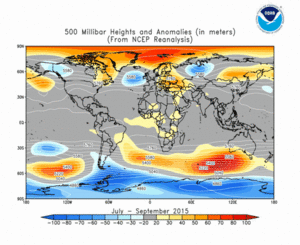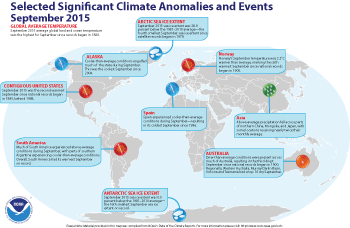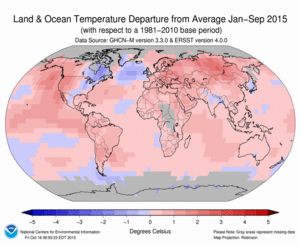Note: This month's global analysis contains slightly less data than is typical, especially in parts of western Africa and western South America. This does not affect the rankings and is taken into account in the uncertainty information in the full report.
Note: With this report and data release, the National Centers for Environmental Information is transitioning to improved versions of its global land (GHCN-M version 3.3.0) and ocean (ERSST version 4.0.0) datasets. Please note that anomalies and ranks reflect the historical record according to these updated versions. Historical months and years may differ from what was reported in previous reports. For more, please visit the associated FAQ and supplemental information.
Introduction
Temperature anomalies and percentiles are shown on the gridded maps below. The anomaly map on the left is a product of a merged land surface temperature (Global Historical Climatology Network, GHCN) and sea surface temperature (ERSST.v4) anomaly analysis as described in Huang et al. (2015). Temperature anomalies for land and ocean are analyzed separately and then merged to form the global analysis. For more information, please visit NCDC's Global Surface Temperature Anomalies page. The percentile map on the right provides additional information by placing the temperature anomaly observed for a specific place and time period into historical perspective, showing how the most current month, season or year compares with the past.
The most current data may be accessed via the Global Surface Temperature Anomalies page.
Temperatures
In the atmosphere, 500-millibar height anomalies correlate well with temperatures at the Earth's surface. The average position of the upper-level ridges of high pressure and troughs of low pressure—depicted by positive and negative 500-millibar height anomalies on the  September 2015 and
September 2015 and  July–September 2015 maps—is generally reflected by areas of positive and negative temperature anomalies at the surface, respectively.
July–September 2015 maps—is generally reflected by areas of positive and negative temperature anomalies at the surface, respectively.
September
The combined average temperature over global land and ocean surfaces for September 2015 was the highest for September in the 136-year period of record, at 0.90°C (1.62°F) above the 20th century average of 15.0°C (59.0°F), surpassing the previous record set last year in 2014 by 0.12°C (0.19°F). This marks the fifth consecutive month a monthly high temperature record has been set and is the highest departure from average for any month among all 1629 months in the record that began in January 1880. The September temperature is currently increasing at an average rate of 0.06°C (0.11°F) per decade.
Separately, the September average temperature across global land surfaces was 1.16°C (2.09°F) above the 20th century average, also the highest for September on record. Large regions of Earth's land surfaces were much warmer than average, according to the Land & Ocean Temperature Percentiles map above. Record warmth was observed across northeastern Africa stretching into the Middle East, part of southeastern Asia, most of the northern half of South America, and parts of central and eastern North America. Southern South America, far western Canada, Alaska, and a swath across central Asia were cooler or much cooler than average.
Select national information is highlighted below. (Please note that different countries report anomalies with respect to different base periods. The information provided here is based directly upon these data):
- In Canada, Ontario had a record warm September. Temperatures were above average by up to 5°C (9°F) across the province.
- The United States had its second warmest September on record, with a temperature 2.1°C (3.7°F) above the 20th century average. Record and near-record warmth spanned most of the country, with nine states in the Northeast, Midwest, and Southwest record warm.
- The September temperature for Norway was 2.2°C (4.0°F) higher than the 1961–1990 average. This marks the sixth warmest September for the country since national records began in 1900. Parts of northern Norway and Trøndelag were 3–4°C (5–7°F) warmer than average.
- It was the coldest September in Spain since 1996, at 0.8°C (1.4°F) below the 1981–2010 national average. Some areas of northern Spain were 1.5‐2.5°C (2.7–4.5°F) cooler than their monthly averages.
- The United Kingdom also had a September temperature that was 0.8°C below the 1981–2010 average. England and Wales each observed their coolest September since 1994.
With strong El Niño conditions in place, the September global sea surface temperature was 0.81°C (1.46°F) above the 20th century average of 16.2°C (61.1°F), the highest departure for September on record, beating the previous record set last year by 0.07°C (0.13°F). This departure from average is also 0.25°C (0.45°F) higher than the global ocean temperature for September 1997, when the last strong El Niño occurred. Sea surface temperatures during September 2015 were well above the 1981–2010 average in the central equatorial Pacific Ocean, according to analysis by the NOAA Climate Prediction Center (CPC). Record warm and much warmer than average temperatures are notable across the entire area, as shown by the September Temperature Percentiles map above. The CPC expects this El Niño to peak in late fall/early winter and estimates there is about a 95 percent chance that El Niño will continue through the Northern Hemisphere winter 2015/16, gradually weakening through spring 2016. This forecast focuses on the ocean surface temperatures between 5°N and 5°S latitude and 170°W to 120°W longitude, called the Niño 3.4 region.
Other areas across the world's ocean surfaces also experienced record warmth or much warmer-than-average conditions for September, including the entire Indian Ocean, most of the central Atlantic and part of the South Atlantic, and the Greenland, Norwegian, and Barents Seas in the Arctic. A large patch in the Atlantic Ocean south of Greenland remained much cooler than average. Waters in the northwestern Pacific and around the southern tip of South America were also cooler than average, with a small region near Antarctica record cold.
| September | Anomaly | Rank (out of 136 years) | Records | ||||
|---|---|---|---|---|---|---|---|
| °C | °F | Year(s) | °C | °F | |||
| Global | |||||||
| Land | +1.16 ± 0.24 | +2.09 ± 0.43 | Warmest | 1st | 2015 | +1.16 | +2.09 |
| Coolest | 136th | 1912 | -0.77 | -1.39 | |||
| Ocean | +0.81 ± 0.03 | +1.46 ± 0.05 | Warmest | 1st | 2015 | +0.81 | +1.46 |
| Coolest | 136th | 1908 | -0.45 | -0.81 | |||
| Land and Ocean | +0.90 ± 0.10 | +1.62 ± 0.18 | Warmest | 1st | 2015 | +0.90 | +1.62 |
| Coolest | 136th | 1912 | -0.50 | -0.90 | |||
| Northern Hemisphere | |||||||
| Land | +1.20 ± 0.25 | +2.16 ± 0.45 | Warmest | 1st | 2015 | +1.20 | +2.16 |
| Coolest | 136th | 1912 | -0.92 | -1.66 | |||
| Ocean | +1.07 ± 0.03 | +1.93 ± 0.05 | Warmest | 1st | 2015 | +1.07 | +1.93 |
| Coolest | 136th | 1904 | -0.57 | -1.03 | |||
| Land and Ocean | +1.12 ± 0.13 | +2.02 ± 0.23 | Warmest | 1st | 2015 | +1.12 | +2.02 |
| Coolest | 136th | 1912 | -0.70 | -1.26 | |||
| Southern Hemisphere | |||||||
| Land | +1.05 ± 0.18 | +1.89 ± 0.32 | Warmest | 5th | 2014 | +1.27 | +2.29 |
| Coolest | 132nd | 1891 | -0.83 | -1.49 | |||
| Ocean | +0.62 ± 0.06 | +1.12 ± 0.11 | Warmest | 1st | 2015 | +0.62 | +1.12 |
| Coolest | 136th | 1911 | -0.46 | -0.83 | |||
| Land and Ocean | +0.68 ± 0.08 | +1.22 ± 0.14 | Warmest | 2nd | 2014 | +0.69 | +1.24 |
| Coolest | 135th | 1911 | -0.51 | -0.92 | |||
| Arctic | |||||||
| Land and Ocean | +0.86 ± 0.22 | +1.55 ± 0.40 | Warmest | 9th | 2006, 2009, 2012 | +1.29 | +2.32 |
| Coolest | 128th | 1992 | -0.99 | -1.78 | |||
The most current data September be accessed via the Global Surface Temperature Anomalies page.
Year-to-date (January–September)
The first nine months of 2015 comprised the warmest such period on record across the world's land and ocean surfaces, at 0.85°C (1.53°F) above the 20th century average, surpassing the previous records of 2010 and 2014 by 0.12°C (0.21°F). Seven months this year, including the past five, have been record warm for their respective months. January was the second warmest January on record and April third warmest.
The average global sea surface temperature of +0.69°C (+1.24°F) for the year-to-date was the highest for January–September in the 136-year period of record, surpassing the previous record of 2014 by 0.06°C (0.11°F). The average land surface temperature departure from average of +1.28°C (+2.30°F) was also the highest on record for September, surpassing the previous record of 2007 by 0.16°C (0.29°F).
Most of the world's land areas were much warmer than average, falling within the top 10 percent of their historical temperature range for the January–September period, as indicated by the Temperature Percentiles map above. These regions include nearly all of South America, Africa, Eurasia, and western North America, with record warmth particularly notable across much of South America and part of central Siberia.
The oceans were also much warmer than average across vast expanses, with much of the eastern and equatorial Pacific Ocean, the Barents Sea in the Arctic, and large parts of the western North Atlantic and Indian Ocean record warm. In the North Atlantic, a large region south of Greenland was much cooler than average, with some record cold embedded in that area. Over land, only part of eastern Canada and the southern tip of South America were cooler than average during the January–September period.
| January–September | Anomaly | Rank (out of 136 years) | Records | ||||
|---|---|---|---|---|---|---|---|
| °C | °F | Year(s) | °C | °F | |||
| Global | |||||||
| Land | +1.28 ± 0.22 | +2.30 ± 0.40 | Warmest | 1st | 2015 | +1.28 | +2.30 |
| Coolest | 136th | 1893 | -0.70 | -1.26 | |||
| Ocean | +0.69 ± 0.03 | +1.24 ± 0.05 | Warmest | 1st | 2015 | +0.69 | +1.24 |
| Coolest | 136th | 1911 | -0.49 | -0.88 | |||
| Land and Ocean | +0.85 ± 0.10 | +1.53 ± 0.18 | Warmest | 1st | 2015 | +0.85 | +1.53 |
| Coolest | 136th | 1911 | -0.48 | -0.86 | |||
| Northern Hemisphere | |||||||
| Land | +1.39 ± 0.26 | +2.50 ± 0.47 | Warmest | 1st | 2015 | +1.39 | +2.50 |
| Coolest | 136th | 1893 | -0.75 | -1.35 | |||
| Ocean | +0.82 ± 0.03 | +1.48 ± 0.05 | Warmest | 1st | 2015 | +0.82 | +1.48 |
| Coolest | 136th | 1904 | -0.49 | -0.88 | |||
| Land and Ocean | +1.04 ± 0.15 | +1.87 ± 0.27 | Warmest | 1st | 2015 | +1.04 | +1.87 |
| Coolest | 136th | 1893, 1904 | -0.51 | -0.92 | |||
| Southern Hemisphere | |||||||
| Land | +1.02 ± 0.15 | +1.84 ± 0.27 | Warmest | 1st | 2015 | +1.02 | +1.84 |
| Coolest | 136th | 1891 | -0.74 | -1.33 | |||
| Ocean | +0.60 ± 0.03 | +1.08 ± 0.05 | Warmest | 1st | 2015 | +0.60 | +1.08 |
| Coolest | 136th | 1911 | -0.50 | -0.90 | |||
| Land and Ocean | +0.67 ± 0.07 | +1.21 ± 0.13 | Warmest | 1st | 2015 | +0.67 | +1.21 |
| Coolest | 136th | 1911 | -0.52 | -0.94 | |||
| Arctic | |||||||
| Land and Ocean | +1.57 ± 0.23 | +2.83 ± 0.41 | Warmest | 1st | 2015 | +1.57 | +2.83 |
| Coolest | 136th | 1888 | -1.14 | -2.05 | |||
The most current data September be accessed via the Global Surface Temperature Anomalies page.
Precipitation
September
The maps below represent precipitation percent of normal (left, using a base period of 1961–1990) and precipitation percentiles (right, using the period of record) based on the GHCN dataset of land surface stations. As is typical, precipitation anomalies during September 2015 varied significantly around the world.
Select national information is highlighted below. (Please note that different countries report anomalies with respect to different base periods. The information provided here is based directly upon these data):
- Rainfall across Australia was the third lowest for September in the 116-year period of record, at 6.2 mm, which is 37 percent of average precipitation. Rainfall in all states and territories was below average. The Murray-Darling Basin and the states of Western Australia, Tasmania, and Victoria each experienced one of their ten driest Septembers on record. El Niño is usually associated with below-average spring rainfall over eastern Australia. As noted above, a strong El Niño is currently in place.
- The Southwest Monsoon continued its withdrawal from India at the end of September. Rainfall for the seasonal period June 1st to September 30th was 86 percent of the 1951–2000 average. About half of India received normal rainfall, while the other half received deficient rainfall (less than 80 percent of average).
References
- Peterson, T.C. and R.S. Vose, 1997: An Overview of the Global Historical Climatology Network Database. Bull. Amer. Meteorol. Soc., 78, 2837-2849.
- Huang, B., V.F. Banzon, E. Freeman, J. Lawrimore, W. Liu, T.C. Peterson, T.M. Smith, P.W. Thorne, S.D. Woodruff, and H-M. Zhang, 2015: Extended Reconstructed Sea Surface Temperature Version 4 (ERSST.v4). Part I: Upgrades and Intercomparisons. J. Climate, 28, 911-930.
 NOAA's National Centers for Environmental Information
NOAA's National Centers for Environmental Information










